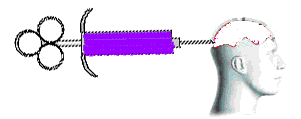Reception theory is a version of reader response literary theory that emphasizes the reader's reception of a literary text. It is more generally called audience reception. Cultural theorist Stuart Hall is one of the main proponents of reception theory. This approach to textual analysis focuses on the scope for "negotiation" and "opposition" on the part of the audience. This means that a "text"- be it a book, movie, or other creative work - is not simply passively accepted by the audience, but that the reader / viewer interprets the meanings of the text based on their individual cultural background and life experiences. In other words, the meaning of the text is created within the relationship between the text and the viewer/reader.
Applying this theory to our chosen brief of advertisement it suggests that our campaign will have to connect with the viewer and give them something to relate to. The energy drink advertisements I have previously analysed use this theory as they relate to the viewer by showing the effect that their product will have on their exercise. This is a common theme in many adverts, especially those of the energy drink variety, and will need to be considered when producing our advertisement.
The Hypodermic Needle Model
 Dating from the 1920s, this theory was the first attempt to explain how mass audiences might react to mass media. As the picture suggests that audiences passively receive the information transmitted via a media text, without any attempt on their part to process or challenge the data. This theory was developed in an age where mass media was a fairly new phenomenon - radio and cinema were less than two decades old. The Hypodermic Needle Model suggests that the information from a text passes into the mass consciouness of the audience, i.e the intelligence and opinion of an individual are not relevant to the reception of the text. This theory suggests that, as an audience, we are manipulated by the creators of media texts, and that our behaviour and thinking might be easily changed by media-makers.
Dating from the 1920s, this theory was the first attempt to explain how mass audiences might react to mass media. As the picture suggests that audiences passively receive the information transmitted via a media text, without any attempt on their part to process or challenge the data. This theory was developed in an age where mass media was a fairly new phenomenon - radio and cinema were less than two decades old. The Hypodermic Needle Model suggests that the information from a text passes into the mass consciouness of the audience, i.e the intelligence and opinion of an individual are not relevant to the reception of the text. This theory suggests that, as an audience, we are manipulated by the creators of media texts, and that our behaviour and thinking might be easily changed by media-makers.
The target audience for sports drinks such as our product is a mass market meaning it is likely to be consumed by all types of people reguardless of their opinion and intelligence. This suggests that this theory is relevent to our product as the information in our advert doesn't need to be complicated. This is the case in the Rooney Powerade advert where the benefits of the product are shown quite clearly, in the form of pictures, and therefore absorbed easily by all viewers.
Consumer Involvement Theory
When the time comes to put pencil to paper, fingers to keyboard - to actually create a campaign or ad - it can be helpful to consider, "OK, what's the primary reaction I want from the target audience?"
You won't need to do this with every ad. But for new clients, new campaigns, or new ways of thinking, it can be clever to go back to basics.
What you will discover is that there are three primary responses your ads can trigger. Three basic things an advertising campaign can get people to do:
1. To feel, to experience an emotion
2. To think, to understand, perhaps remember
3. Take action, do something
Our Advert isn't likely to make the audience feel too many emotions. It may cause the viewer to think however. We hope to make them think about the product, to understand how it can benefit them in the future and possibly cause them to remeber a time when they were in similar circumstances to that of the actor in the advert and how our product could of helped them. All of these will hopefully result in them buying our product the next time they go shopping (action).






